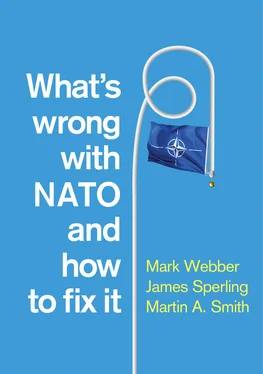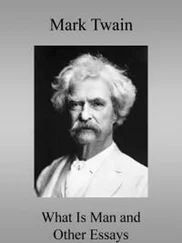Declinist positions resurfaced at the Cold War’s end only to be confounded by NATO’s repurposing in the 1990s. By 1995, one analyst was able to write that ‘European security was once again dominated by the NATO alliance and US leadership, perhaps to a greater extent than even in the last years of the Cold War.’ 16The prompt for that verdict was the Alliance’s decisive aerial intervention in Bosnia. Operation Deliberate Force, launched in August 1995, served as the catalyst for the Dayton Peace Accords, which finally brought a semblance of political stability to the troubled Balkan region. It also marked NATO’s entry into peacekeeping (60,000 NATO personnel would go on to be deployed to Bosnia, the largest military deployment in Europe since World War II). NATO undertook a further air operation four years later. Operation Allied Force pushed the Serb leader Slobodan Milošević to a peace deal over Kosovo and paved the way for the entry of the KFOR (Kosovo Force) peacekeeping mission to the troubled province. A smaller-scale NATO intervention in neighbouring Macedonia in 2001 also had a decisive effect in restoring political order. NATO’s attentions then moved to the far-off theatre of Afghanistan. In 2003, it assumed formal responsibility for the International Security Assistance Force (ISAF). ISAF would prove NATO’s most complex and demanding mission of the post-Cold War period, entailing both nation-building and gruelling counter-insurgency warfare. In 2015, a new non-combat mission, Operation Resolute Support, was initiated. These missions (along with a further aerial campaign, Operation Unified Protector, in Libya in 2011, and the return to collective defence in the face of Russia’s actions against Ukraine after 2014) have not been without their problems, as was noted above. But even if one accepts the criticism that NATO operations have lacked an overarching sense of strategic purpose, taken together they are nonetheless a measure of allied staying power. 17
An organization whose purpose is to protect the security of its members will necessarily have to confront its enemies and face down threats. Dealing with crisis – whether in the Balkans, Afghanistan, Libya or on NATO’s eastern flank facing Russia – is simply part and parcel of what NATO does. To infer from such a state of affairs that NATO itself is ‘in crisis’ is a mistaken leap of logic. 18Time and again, the Alliance has proven its naysayers wrong as it has responded, rather than surrendered, to some of the tough security challenges of the late twentieth and early twenty-first centuries.
If we accept that NATO is here to stay, an argument still needs to be made as to why this is a good thing. The merits of that argument rest, in large part, on NATO’s own claims to performance: how effectively the Alliance has executed its various missions and, related to this, how convincing have been the reasons for pursuing them. We shall return to these themes throughout the book. Here it is worth putting them in context. Our second assumption is that NATO can undertake operations and, indeed, engage in its full range of activities (military exercises, ballistic missile defence [BMD], nuclear deterrence, partnerships, joint intelligence, surveillance and reconnaissance [JISR], cyber defence, air and maritime patrols, and so on) owing to the development of some unique characteristics.
Ostensibly, NATO is simply a treaty-based alliance of states, a fairly conventional category in international politics. It is, however, much more besides. Since the signing of the North Atlantic Treaty in 1949, the number of NATO allies has grown (from the original twelve to thirty today) and, in parallel, NATO has developed a sophisticated institutional set-up. NATO, consequently, is as much an international organization as it is a military alliance. We will have more to say on this in Chapter 1. The point here is that these ‘institutional assets’, although initially developed during the Cold War, have proven flexible enough to ensure significant NATO adaptation in the three decades since. 19Adaptation has, operationally speaking, not always generated the right results; it has also been painful as NATO has had to learn by doing in the field of operations. Yet adaptation has certainly been dramatic. In the Balkans, Afghanistan and Libya, NATO laid down a series of firsts – in terms of its willingness to work with non-NATO partners, its ability to provide massive and sustained concentrations of force on land, sea and air, and the expansion of its geographical area of operations. 20
Alongside these formal structures, NATO has also developed all manner of informal practices of social and political interaction. Allies working in an organization premised on transparency and consensus have thus developed feelings of familiarity and trust in their mutual relations. 21It was noted above that political community, one outgrowth of this dynamic, has been eroded. But an equally important aspect of community remains. NATO is the exemplary case of a ‘pluralistic security community’. Its members hold ‘dependable expectations of peaceful change’ in their relations with one another such that war between them is rendered unthinkable. 22A willingness to desist from violence among one’s peers may be a minimum condition of community, but, given Europe’s history, it is an undeniably important one. The anchoring of Germany within NATO has put paid to any fear among its neighbours of German military revanchism. NATO has also played a role in mitigating the antagonism between Greece and Turkey. The embrace of new members among some former Yugoslav republics is premised on doing something similar in the Balkans.
Both its informal and formal characteristics place NATO at some remove from more transient coalitions of the willing. Modern warfare is rarely conducted by states acting alone. Even powerful states such as the US have come to rely on allies to give added legitimacy to their cause or to widen the pool of assets upon which they can call. Here, a temporary coalition has certain advantages: flexibility of purpose, fluidity of decision-making and ease of dissolution when its purpose has been served. Coalitions, not alliances as such, fought wars against Iraq in 1990/1 and 2003, and since September 2014 a global coalition has battled ISIS in Iraq and Syria. Yet coalitions by their very nature lack the embedded structures and assets of a permanent alliance such as NATO. NATO’s internal politics may mean sluggish decision-making, and capability asymmetries among its members often give rise to burden-sharing disputes. But when NATO acts, it enjoys the benefits of interoperability, unity of command and pooled resources – all of which are an aid to ‘effectiveness [...] robustness and adaptability’. 23
There is no substitute for NATO
The particular institutional form the Alliance has taken marks it out from other organizational alternatives. The EU, the United Nations (UN) and the Organization for Security and Cooperation in Europe (OSCE) can all lay claim to promoting security. None, however, is possessed of the institutional and military assets described above. None would have been capable of mounting combat operations in the Balkans, Libya and Afghanistan, or of replicating NATO’s Readiness Action Plan to provide reassurance to the Baltic States and Poland in the face of Russian military might.
Three other points are also worth making by way of comparison. First, the US and the UK have consistently given priority to NATO. That choice determined NATO’s European ascendancy at the end of the Cold War. London and Washington have ever since been lukewarm about the idea of an EU role in military security for fear that it will encroach upon alliance prerogatives. As the UK exits from the EU, such scepticism is only likely to increase. Non-EU Turkey has adopted a similar stance. France and Germany, by contrast, have tended to talk up the security and nascent military functions of the EU, but neither has ever contemplated abandoning NATO in order to support a distinct European alternative.
Читать дальше












